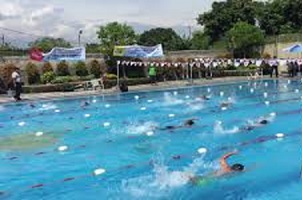
Swimming races began in Europe around 1800. Most swimmers swim in a breaststroke. In 1873, John Arthur Trudgen introduced the trudgen style in swimming competitions after imitating the Indian free-style swimming. As a result of the British dislike of the swimming movement that splashes water here and there, Trudgen replaces freestyle leg movements whipping up and down into scissor foot movements such as side-style swimming.
Swimming has been a sport that has been contested since the 1896 Athens Olympics. Women's swimming numbers have been contested since the Stockholm Olympics in 1912. In 1902, Richard Cavill introduced freestyle swimming. The International Swimming Federation was formed in 1908. Butterfly style was first developed in the 1930s. In the beginning, the butterfly style was a variation of chest style before being considered as a separate swimming style in 1952.
In the Dutch East Indies, the Bandung Swim Association (Bandungse Zwembond) was founded in 1917. The following year the West Java Zwembond Swim Association was established, and the East Java Swim Association (Oost Java Zwembond) was founded in 1927. Since then, the inter-regional swimming competition began often held. The record in the championships is also listed as a record in the Netherlands.
In 1936, the Dutch East Indies swimmer named Pet Stam set a record of 59.9 seconds for the 100 meters freestyle at the Cihampelas Bandung swimming pool. Pet Stam was sent as a Dutch representative at the 1936 Berlin Olympics. The Indonesian Swimming Association was founded on 21 March 1951, and as a member of the International Swimming Federation since the following year. Indonesian swimmers competed in the 1952 Helsinki Olympics.
In an important international race or race, an automatic time-measuring touch board is installed on both sides of the pool wall. This touch board thickness is only 1 cm.
Swimmers record their time on the touch board during reversals and finishes. Omega's production time measuring board starts to be used at the 1967 Pan-American Games in Winnipeg, Canada.
Start block [edit | edit source]
At each start beam there is a loudspeaker to voice the gun start and sensor measuring the time meter which starts the note when the swimmer jumps from the start beam.
The starting beam height is between 0.5 m to 0.75 from the water surface. The starting beam size is 0.5 x 0.5 m, and the top is coated with antilicin. The starting beam slope does not exceed 10 °.
Swimming competitions consist of race numbers according to distance, gender, and four swimming styles (freestyle, butterfly style, backstroke, and breaststroke). Male and female swimming numbers competed in the Olympics:
• Freestyle: 50 m, 100 m, 200 m, 400 m, 800 m (daughter), 1500 m (son)
• Butterfly style: 100 m, 200 m
• Back force: 100 m, 200 m
• Chest style: 100 m, 200 m
• Individual changing force: 200 m, 400 m
• Relay change style: 4 x 100 m
• Freestyle relay: 4 x 100 m, 4 x 200 m
• 10 km Marathon. [8]
The International Swimming Federation recognizes the men's / women's world record for swimming numbers:
• Freestyle: 50 m, 100 m, 200 m, 400 m, 800 m, 1500 m
• Back force: 50 m, 100 m, 200 m
• Chest style: 50 m, 100 m, 200 m
• Butterfly style: 50 m, 100 m, 200 m
• Individual change force: 100 m (only short trajectory), 200 m, 400 m
• Change-style relay: 4 × 100 m
• Freestyle relay: 4 × 100 m, 4 × 200 m. [9]
In individual dressing styles, a swimmer uses four styles alternately for one round, in the order: butterfly style, backstroke, breaststroke, and freestyle. In the individual 100m change in swimming number, the race is held in a 25 m short lap pool.
At number 4 x 100 m relay style, one team represented four swimmers who each swam 100 m. The first swimmer starts with a backstroke, followed by a breaststroke swimmer, a butterfly swimmer, and ends by a freestyle swimmer.
Comments